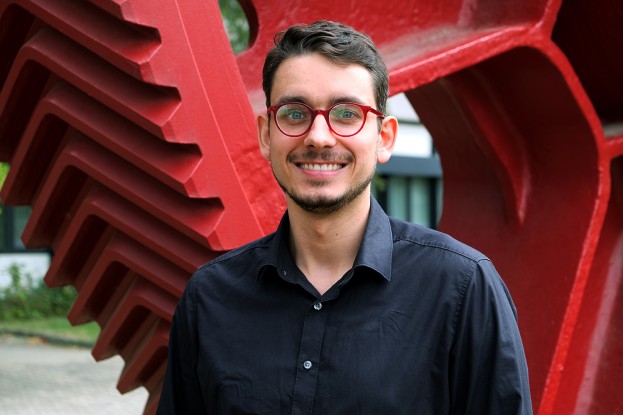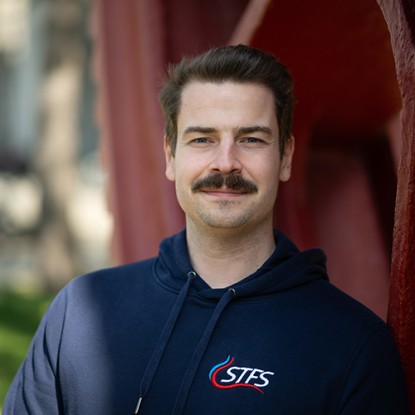Team
| Name | Contact | |
|---|---|---|

| Prof. Dr.-Ing. Christian Hasse | hasse@stfs.tu-... +49 6151 16-24142 L1|01 281 |

| Max Hasenzahl M.Sc. | hasenzahl@stfs.tu-... +49 6151 16-24147 L1|01 290 |

| Benjamin Traut M.Sc. | traut@stfs.tu-... L1|01 285 |
Motivation
In the context of global warming, the necessity of efficient and low emission combustion applications arises. In addition to alternative fuels, the current tendency is towards smaller, internal combustion (IC) engines, which enable higher pressure ratios and, therefore, reach higher efficiencies. However, this evolution increases the surface-to-volume ratio, which leads to a growing influence of near-wall phenomena on the overall combustion process. The interaction of the flame with the surrounding walls has a crucial effect on the overall efficiency. Due to heat-losses at the cold walls, the chemical reactions stagnate. These effects lead to incomplete combustion close to the walls and impacts pollutant formation. The underlying processes of the chemical reacting near-wall flow need to be understood to develop new models and simulation tools for modern, low emission internal combustion engines.
Objectives
The main objective of this project is the scale-resolving simulation and modeling of flame-wall interactions to allow a deeper understanding of the underlying physical processes and improve numerical models used in the simulation of technical combustors. Therefore, different configurations are analyzed:
The generic side-wall quenching experiment (see A04): In these configurations, the fundamentals of flame-wall interactions under atmospheric and pressurized conditions are analyzed, including the impact of pressure on wall-related mechanisms, the influence of mixture inhomogeneities as well as turbulence-chemistry interaction. The understanding of these fundamental processes enables the simulation of realistic engine applications. The measurements performed in A04 serve as reference data for the simulations performed on the generic configurations.
The optical IC engine (see C01): The findings of the generic configurations allow the modeling of the processes in towed and fired engine operation, which can be used for the detailed investigation of near-wall flow, combustion, and pollutant formation in IC engines. A key challenge of this configuration is the interplay of the different mathematical models required to analyze the processes in the IC engine. Within this investigation, the experimental results from C01 serve as reference data.
Previous Findings
The numerical analysis of laminar SWQ using fully-resolved chemistry and transport (FCT) simulations revealed the crucial role of near-wall diffusive processes on the thermo-chemical state in the vicinity of walls, especially concerning pollutant formation. Even though classical tabulation approaches using stationary flamelets, like Flamelet-Generated Manifolds (FGM), predict the flame structure and main species accurately, minority species such as CO show a significant deviation. This deviation could be associated with errors in the scalar dissipation rates. Based on these findings, requirements for the development of improved chemistry modeling were deduced before a wall-adapted, reduced chemistry model was derived with REDIM (B06). Further, the importance of differential diffusion effects in alternative fuels, such as dimethyl ether, and the role of low-temperature chemistry was clarified using a combination of FCT simulations and measurements of the thermochemical states defined by the mole fractions of CO2, CO, and T.
In addition to the laminar SWQ, turbulent flame-wall interaction was studied. A Direct Numerical Simulation (DNS) of a V-shaped flame in a generic channel flow was performed that revealed detailed insights into the physical phenomena during turbulent flame-wall interactions. Using the DNS data, a statistical sub-grid scale closure model, the Conditional Quadrature Method of Moments (CQMOM), was developed and validated. The CQMOM is coupled to a chemistry manifold and models the unresolved fluctuations of the reactive scalars and enthalpy using a bivariate probability density function that is approximated by its moments. Further, in correspondence to the experimental investigations in A04, a flame tip vortex interaction (Figure 2) was found that leads to exhaust gas recirculation close to the quenching point. The exhaust gas recirculation shifts the thermochemical state. These effects need to be accounted for in reduced chemistry closure models.
CFD Framework
A specialized CFD framework has been developed to transfer this knowledge to the simulation of internal combustion engines. This framework enables the simulation of internal combustion engines with high-quality meshes and the multicycle LES approach.
The engine investigated in C01 has been simulated in motored operating conditions and is validated against the experimental measurement of the in-cylinder velocity field. The simulations have shown cycle-cycle variability of the flow above the piston walls during the compression phase. The variability is related to the decay of the macro flow structure (i.e., tumble flow). It is therefore confirmed that the in-cylinder flow evolution affects the evolution of the boundary layer.
The framework has been extended to simulate the direct injection process. A multi-hole gasoline injector is simulated in parallel to the motored simulation following the experiments. The results match the measurements and have shown a strong interaction between the in-cylinder and the spray.
Approach
The simulations within this subproject are simulated using the open-source software library OpenFOAM. The numerical setups are determined by the experimental counterparts in subprojects A04 (generic experiments) and C01 (IC engine) and serve as digital twin of the respective experimental configurations. For the generic side-wall quenching configuration (A04) the combustion processes are modeled using detailed and tabulated chemistry. The turbulent flame-wall interactions are analyzed using direct numerical sLarge-Eddy Simulations (LES) with tabulated chemistry.
In the IC engine (C01) URANS and LES simulations are performed and the investigation of the interaction between the applied mathematical models in a complex application, such as the IC engine, is an important challenge of this subproject.
Current Work
Currently, the investigations of the generic side-wall quenching configurations focus on the influence of higher pressures and mixture inhomogeneities. The findings are then extended to the more complex dimethyl carbonate (DMC). The numerical simulations are performed in accordance with the measurement data of subproject A04. The findings are then transferred to the models used in the engine simulations.
The combustion models are deployed into the engine model framework to simulate fired operating conditions, first with a homogenous fuel mixture and then an inhomogeneous mixture. The last case is obtained by the previous simulation of the direct injection spray.
Furthermore, the interaction of the in-cylinder flow with the piston is investigated. The near-wall region is simulated with a wall model LES (WM-LES) through a highly resolved grid to deploy a wall-model LES. The velocity fields on the mesh boundary are extracted by previous multicycle simulation. This approach allows to resolve the turbulence structures up to the wall and consider the influence of the in-cylinder flow (and its cycle-cycle variability) on the boundary layer evolution.
Cooperation
The main target of this project is to extend the knowledge of flame-wall interactions with a special emphasis on IC engines. Due to the high complexity of the processes in the IC engines different mathematical models are required for the simulation of IC engines. These include turbulence models (developed in B03) and chemistry tabulation (developed with B06). Furthermore, experimental investigations serve as reference data for the generic configurations (A04) and the IC engine (C01).








